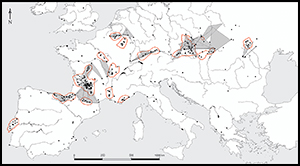Crossref Citations
This article has been cited by the following publications. This list is generated based on data provided by
Crossref.
Solich, Martin
and
Bradtmöller, Marcel
2017.
Socioeconomic complexity and the resilience of hunter-gatherer societies.
Quaternary International,
Vol. 446,
Issue. ,
p.
109.
Schmidt, Isabell
Zimmermann, Andreas
and
Biehl, Peter F.
2019.
Population dynamics and socio-spatial organization of the Aurignacian: Scalable quantitative demographic data for western and central Europe.
PLOS ONE,
Vol. 14,
Issue. 2,
p.
e0211562.
Weniger, Gerd-Christian
de Andrés-Herrero, María
Bolin, Viviane
Kehl, Martin
Otto, Taylor
Potì, Alessandro
Tafelmaier, Yvonne
and
Peresani, Marco
2019.
Late Glacial rapid climate change and human response in the Westernmost Mediterranean (Iberia and Morocco).
PLOS ONE,
Vol. 14,
Issue. 12,
p.
e0225049.
Lundström, Victor
and
Riede, Felix
2019.
A spatially explicit model of Final Palaeolithic population densities for southern Scandinavia in the period between 14,000 and 12,700 cal BP.
Journal of Archaeological Science: Reports,
Vol. 26,
Issue. ,
p.
101886.
Nowell, April
and
French, Jennifer C.
2020.
Adolescence and innovation in the European Upper Palaeolithic.
Evolutionary Human Sciences,
Vol. 2,
Issue. ,
Mounier, Aurélien
Heuzé, Yann
Samsel, Mathilde
Vasilyev, Sergey
Klaric, Laurent
and
Villotte, Sébastien
2020.
Gravettian cranial morphology and human group affinities during the European Upper Palaeolithic.
Scientific Reports,
Vol. 10,
Issue. 1,
Page, Abigail E.
and
French, Jennifer C.
2020.
Reconstructing prehistoric demography: What role for extant hunter‐gatherers?.
Evolutionary Anthropology: Issues, News, and Reviews,
Vol. 29,
Issue. 6,
p.
332.
Willmes, Christian
Niedziółka, Kamil
Serbe, Benjamin
Grimm, Sonja B.
Groß, Daniel
Miebach, Andrea
Märker, Michael
Henselowsky, Felix
Gamisch, Alexander
Rostami, Masoud
Mateos, Ana
Rodríguez, Jesús
Limberg, Heiko
Schmidt, Isabell
Müller, Martin
Hölzchen, Ericson
Holthausen, Michael
Klein, Konstantin
Wegener, Christian
Weninger, Bernhard
Nielsen, Trine Kellberg
Otto, Taylor
Weniger, Gerd-Christian
Bubenzer, Olaf
and
Bareth, Georg
2020.
State of the Art in Paleoenvironment Mapping for Modeling Applications in Archeology—Summary, Conclusions, and Future Directions from the PaleoMaps Workshop.
Quaternary,
Vol. 3,
Issue. 2,
p.
13.
Douka, Katerina
Chiotti, Laurent
Nespoulet, Roland
and
Higham, Thomas
2020.
A refined chronology for the Gravettian sequence of Abri Pataud.
Journal of Human Evolution,
Vol. 141,
Issue. ,
p.
102730.
Lundström, Victor
Peters, Robin
and
Riede, Felix
2021.
Demographic estimates from the Palaeolithic–Mesolithic boundary in Scandinavia: comparative benchmarks and novel insights.
Philosophical Transactions of the Royal Society B: Biological Sciences,
Vol. 376,
Issue. 1816,
p.
20200037.
Villaverde, Valentín
Sanchis, Alfred
Badal, Ernestina
Bel, Miguel Ángel
Bergadà, M. Mercè
Eixea, Aleix
Guillem, Pere M.
Martínez-Alfaro, Álvaro
Martínez-Valle, Rafael
Martínez-Varea, Carmen M.
Real, Cristina
Steier, Peter
and
Wild, Eva M.
2021.
Cova de les Malladetes (Valencia, Spain): New Insights About the Early Upper Palaeolithic in the Mediterranean Basin of the Iberian Peninsula.
Journal of Paleolithic Archaeology,
Vol. 4,
Issue. 1,
Johnson, Richard J.
Lanaspa, Miguel A.
and
Fox, John W.
2021.
Upper Paleolithic Figurines Showing Women with Obesity may Represent Survival Symbols of Climatic Change.
Obesity,
Vol. 29,
Issue. 1,
p.
11.
Maier, A.
Stojakowits, P.
Mayr, C.
Pfeifer, S.
Preusser, F.
Zolitschka, B.
Anghelinu, M.
Bobak, D.
Duprat-Oualid, F.
Einwögerer, T.
Hambach, U.
Händel, M.
Kaminská, L.
Kämpf, L.
Łanczont, M.
Lehmkuhl, F.
Ludwig, P.
Magyari, E.
Mroczek, P.
Nemergut, A.
Nerudová, Z.
Niţă, L.
Polanská, M.
Połtowicz-Bobak, M.
Rius, D.
Römer, W.
Simon, U.
Škrdla, P.
Újvári, G.
and
Veres, D.
2021.
Cultural evolution and environmental change in Central Europe between 40 and 15 ka.
Quaternary International,
Vol. 581-582,
Issue. ,
p.
225.
Klein, Konstantin
Wegener, Christian
Schmidt, Isabell
Rostami, Masoud
Ludwig, Patrick
Ulbrich, Sven
Richter, Jürgen
Weniger, Gerd-Christian
and
Shao, Yaping
2021.
Human existence potential in Europe during the Last Glacial Maximum.
Quaternary International,
Vol. 581-582,
Issue. ,
p.
7.
Demidenko, Yuri E.
2021.
South of Eastern Europe and Upper Paleolithic diversity around the Last Glacial Maximum.
Quaternary International,
Vol. 581-582,
Issue. ,
p.
290.
Anghelinu, Mircea
Niță, Loredana
Veres, Daniel
Hambach, Ulrich
Händel, Marc
Cordoș, Cristina
Ilie, Maria
and
Murătoreanu, George
2021.
Break vs. continuity: Techno-cultural changes across the LGM in the Eastern Carpathians.
Quaternary International,
Vol. 581-582,
Issue. ,
p.
241.
Vogels, Oliver
Fäder, Eymard
and
Lenssen-Erz, Tilman
2021.
A matter of diversity? Identifying past hunter-gatherer aggregation camps through data driven analyses of rock art sites.
Quaternary International,
Vol. 572,
Issue. ,
p.
151.
Johnson, Richard J.
Lanaspa, Miguel A.
and
Fox, John W.
2021.
Response to “Female Figurines, Climate Sensationalism, and Archaeological Shortcomings”.
Obesity,
Vol. 29,
Issue. 5,
p.
782.
Cascalheira, João
Alcaraz-Castaño, Manuel
Alcolea-González, Javier
de Andrés-Herrero, Maria
Arrizabalaga, Alvaro
Aura Tortosa, J. Emili
Garcia-Ibaibarriaga, Naroa
and
Iriarte-Chiapusso, Maria-Jose
2021.
Paleoenvironments and human adaptations during the Last Glacial Maximum in the Iberian Peninsula: A review.
Quaternary International,
Vol. 581-582,
Issue. ,
p.
28.
Peresani, Marco
Monegato, Giovanni
Ravazzi, Cesare
Bertola, Stefano
Margaritora, Davide
Breda, Marzia
Fontana, Alessandro
Fontana, Federica
Janković, Ivor
Karavanić, Ivor
Komšo, Darko
Mozzi, Paolo
Pini, Roberta
Furlanetto, Giulia
Maria De Amicis, Mattia Giovanni
Perhoč, Zlatko
Posth, Cosimo
Ronchi, Livio
Rossato, Sandro
Vukosavljević, Nikola
and
Zerboni, Andrea
2021.
Hunter-gatherers across the great Adriatic-Po region during the Last Glacial Maximum: Environmental and cultural dynamics.
Quaternary International,
Vol. 581-582,
Issue. ,
p.
128.





